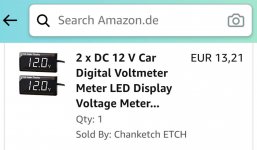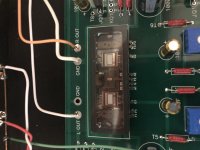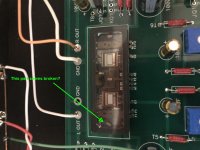You can buy the Caps and Resistors necessary from the completion kit for a lot less. I stand corrected and will go with $100 total investment.
You can buy the Caps and Resistors necessary from the completion kit for a lot less. I stand corrected and will go with $100 total investment.
Yep - under $25 for caps, resistors, a zener diode and terminal blocks for each of my builds. The idea of buying a spare Nutube appeals, for the total cost to complete maybe worthwhile to just build a full board and put it on the shelf 🙂
Aside from the lead clipping, stub removal, solder sucking and resoldering, all the other complication remains the same with a socket.
I'll try to remember to post a walk through in '24 or '25.
When using a socket, the damping approach could be changed so that double-sided adhesive dampening tape is not used. That would avoid the need for extensive clean-up of the tape. Two possibilities: single sided adhesive damping tape; the sticky damping putty that is a repurposed from use as a poster mounting material (find in art supply stores). If one is willing to do some board modification, there is also the possibility of using nylon screws and nuts together with a metal crosspiece over the top, with single-sided dampening tape or sorbothane to put slight (!) contact pressure on the top of the tube.
I am offering these ideas up to others who may be reading this thread, rather than to change Mr. Garciaʻs inclination not to use a socket, which of course is his prerogative as DIY. This is the great thing about DIY: we have alternatives!
I plan on moving the B1 Korg to my secondary system and to build the BA2018. I am also going to order an extra tube.
I think the mention of replacing the tube being a 5-minute job was just them saying it will take a short amount of time.
I think the mention of replacing the tube being a 5-minute job was just them saying it will take a short amount of time.
Sometimes these meters cannot use the same power supply that they are measuring. You may need to supply voltage from another source. You can get by powering the meters with a temporary lash-up battery source (too bad Radio Shack is out of business; you could have gone down and purchased a couple of battery holders).
Is there a soft turn-on solution that is somewhat easily implemented and will address the surge damage problem?
I looked at the numbers again. If I have it right, Nelson's choice of 9.1V and 475R in series with each cathode results in a cold-cathode surge of only 2ma above the 17mA target and well below the 25mA maximum. It would be somewhat more if the zener voltage is higher than 9.1V but not much. The constant-current solution would hold it at 17mA in all circumstances and all voltages but my zener is actually under 9.0 volts.
What remains (for me) are the potentially harmful power and merely annoying input switching noises and a desire to conveniently, safely, and silently switch the power amp on or off when I switch the preamp -- all solvable with a small add-on board.
Hello,
if I switch on my audio-system:
1st - the source
2nd - the preamp
3rd - the poweramp
if I switch off my system:
1st - the poweramp (wait till the LEDs in the PSU are off)
2nd - the preamp
3rd - the source.
I never had bad noises following this sequence with my B1 KORG NUTUBE.
🙄
If you are a bit 'lazy' and you use a power distributor socket strip for your system - you switch it on alltogether - don't wonder if you get nasty noises....
Cheers
Dirk
if I switch on my audio-system:
1st - the source
2nd - the preamp
3rd - the poweramp
if I switch off my system:
1st - the poweramp (wait till the LEDs in the PSU are off)
2nd - the preamp
3rd - the source.
I never had bad noises following this sequence with my B1 KORG NUTUBE.
🙄
If you are a bit 'lazy' and you use a power distributor socket strip for your system - you switch it on alltogether - don't wonder if you get nasty noises....
Cheers
Dirk
Hello,
if I switch on my audio-system:
1st - the source
2nd - the preamp
3rd - the poweramp
if I switch off my system:
1st - the poweramp (wait till the LEDs in the PSU are off)
2nd - the preamp
3rd - the source.
I never had bad noises following this sequence with my B1 KORG NUTUBE.
🙄
If you are a bit 'lazy' and you use a power distributor socket strip for your system - you switch it on alltogether - don't wonder if you get nasty noises....
Cheers
Dirk
I do similar Dirk except I turn down input pot on the preamp to zero before turning off the amp when switching off my system. Consequently the preamp’s input pot is always (basically) off on startup.
Cheers,
Pete
Hello,
if I switch on my audio-system:
.............
if I switch off my system:
.............
I never had bad noises following this sequence with my B1 KORG NUTUBE.
: rolleyes:
If you are a bit 'lazy' and you use a power distributor socket strip for your system - you switch it on alltogether - don't wonder if you get nasty noises....
Cheers
Dirk
Yes, a happy ritual for folks who enjoy rituals, I applaud your consistency.
I prefer convenience and certainty -- no nasty noises, ever, for any reason whether due to intentional switching or unexpected power failure; all prevented by a delayed connect at power on and instant disconnect at power off, plus momentary muting when switching inputs. Have designed the board, now just waiting on the parts to stuff . . .
Maybe I've just been lucky (and unlucky) with my B1 NuTube.
Lucky: No microphonics, despite no double-sided tape sticking the tube to the PCB (yuck). Steps I took to reduce microphonics were to mount the pcb on rubber standoffs (https://www.amazon.com/gp/product/B073NYV6RH) and to suspend the tube above the PCB during soldering as recommended in the build guide so that there is a slight gap between the PCB and the tube.
No power-on thump. I have the B1 and my F6 plugged into the same switchable power strip. Turning both on simultaneously causes no power-on noises. Stock board from the DIY store.
Unlucky: My first NuTube failed after less than 6 months of use. Not sure of any proximate cause, though it could've been that I bumped the B1 when it was warm.
Replacement took 30 minutes or so which included the time to remove/replace the board from the chassis. I briefly investigated the possibility of socketing the tube, but couldn't find any readily available solution that could be vouched for. If it fails again, I'll probably replace it one more time and then begin building the Mezmerize B1 - the board is sitting in my closet.
-- Thing
Lucky: No microphonics, despite no double-sided tape sticking the tube to the PCB (yuck). Steps I took to reduce microphonics were to mount the pcb on rubber standoffs (https://www.amazon.com/gp/product/B073NYV6RH) and to suspend the tube above the PCB during soldering as recommended in the build guide so that there is a slight gap between the PCB and the tube.
No power-on thump. I have the B1 and my F6 plugged into the same switchable power strip. Turning both on simultaneously causes no power-on noises. Stock board from the DIY store.
Unlucky: My first NuTube failed after less than 6 months of use. Not sure of any proximate cause, though it could've been that I bumped the B1 when it was warm.
Replacement took 30 minutes or so which included the time to remove/replace the board from the chassis. I briefly investigated the possibility of socketing the tube, but couldn't find any readily available solution that could be vouched for. If it fails again, I'll probably replace it one more time and then begin building the Mezmerize B1 - the board is sitting in my closet.
-- Thing
Maybe I've just been lucky (and unlucky) with my B1 NuTube.
Lucky: No microphonics, despite no double-sided tape sticking the tube to the PCB (yuck). Steps I took to reduce microphonics were to mount the pcb on rubber standoffs (https://www.amazon.com/gp/product/B073NYV6RH) and to suspend the tube above the PCB during soldering as recommended in the build guide so that there is a slight gap between the PCB and the tube.
No power-on thump. I have the B1 and my F6 plugged into the same switchable power strip. Turning both on simultaneously causes no power-on noises. Stock board from the DIY store.
Unlucky: My first NuTube failed after less than 6 months of use. Not sure of any proximate cause, though it could've been that I bumped the B1 when it was warm.
Replacement took 30 minutes or so which included the time to remove/replace the board from the chassis. I briefly investigated the possibility of socketing the tube, but couldn't find any readily available solution that could be vouched for. If it fails again, I'll probably replace it one more time and then begin building the Mezmerize B1 - the board is sitting in my closet.
-- Thing
The power on thump comes pretty quickly. Could it be that your F6 isn't ready when the Korg does its turn-on thing?
The power on thump comes pretty quickly. Could it be that your F6 isn't ready when the Korg does its turn-on thing?
That could well be. However, when the B1 was out of service, I had my old Advent 300 serving as preamp and I did hear a slight thump from that. Maybe it just has a slower thump?
I recently built one of these kits for a friend. DIYAUDIO store was less than helpful and borderline rude about their responses. They referred me here. I believe I have a bad tube. I assembled the kit per the instructions and biased the test points to 10V for 48 hours to ensure they did not drift. All seemed well and it sounded great. I passed it off to the gentleman for whom I built the kit for snd about a week later, one channel went out. The tube is unlit.
Can someone provide the suggested test procedures for the kit to determine that it is the Nutube that is at fault? DIYAUDIO store won’t replace it unless I get a post here stating that the tube is bad.
Thanks for your assistance!
Can someone provide the suggested test procedures for the kit to determine that it is the Nutube that is at fault? DIYAUDIO store won’t replace it unless I get a post here stating that the tube is bad.
Thanks for your assistance!
@deicide67:
Check the filament voltage between T5 and ground and between T6 and ground using a voltmeter that can accurately resolve voltages below 1V. It should be around 0.6V for each reading. Anything higher than 0.8V will exceed the manufacturer's maximum voltage specification. If those voltages are correct, and you have an open filament, then the tube underwent an early failure and was defective in manufacture.
Check the filament voltage between T5 and ground and between T6 and ground using a voltmeter that can accurately resolve voltages below 1V. It should be around 0.6V for each reading. Anything higher than 0.8V will exceed the manufacturer's maximum voltage specification. If those voltages are correct, and you have an open filament, then the tube underwent an early failure and was defective in manufacture.
Do what avdesignguru said. But keep in mind these are diy kits. You can’t expect to have a warranty on something diy…so many things could happen. It’s not Amazon or Costco and the diyaudio store is a not for profit company…it’s designed to provide funds for the maintenance and running of this site.
I understand the liability of assembling DIY devices. That being said, if a component is faulty or fails under strict instructions contained in a manual, the component should be warrantied. Especially after functioning 100% for 48 hours.
If you buy a lift kit for your vehicle and install it. Then one shock fails within the week, is that on you? No. The manufacturer will warranty it.
If you buy a lift kit for your vehicle and install it. Then one shock fails within the week, is that on you? No. The manufacturer will warranty it.
- Home
- Amplifiers
- Pass Labs
- B1 with Korg Triode


